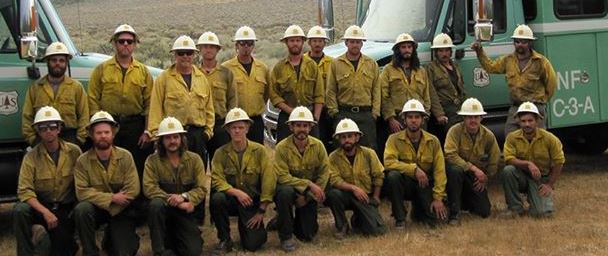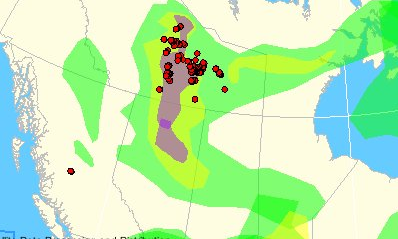Doug “put this video together during an ignition tour in the Northwest Territories this summer”.
Tag: Canada
Wildfire one liners, August 20, 2014

New Hotshot crew: The USFS Forest Service has announced that there is a new Interagency Hotshot Crew on the Inyo National Forest in California.
Foreign aid to Washington: A group of volunteers from Israel is helping residents of Pateros, Washington recover from a devastating wildfire.
How will British Columbia pay for wildfires: While the United States is struggling to make decisions about how to pay for the rising costs of wildfires, British Columbia has similar issues.
Smokey Bear to be Grand Marshall: Smokey Bear will be the Grand Marshall of the New Mexico State Fair parade on September 13 in Albuquerque, in honor of his 70th birthday celebration. September 19 will be Firefighter and Smokey Bear Day at the fair.
1979 British Columbia rappelling film
This film, released in 1979 by the Province of British Columbia Ministry of Forests Protection Branch, introduced viewers to the “Rapattack” program — firefighters rappelling from helicopters to suppress wildfires.
British Columbia: Chelaslie River Fire
The Chelaslie River Fire 126 miles west of Prince George has burned over a quarter of a million acres in British Columbia. Authorities have issued evacuation orders for Entiako Provincial Park and the west half of the Tetachuck Lake area.
The 264,000-acre (107,000 hectares) fire, discovered July 8, started from lightning. It is being fought by 290 personnel and 18 helicopters.
The description of current activities found on the British Columbia government website uses some jargon that may be foreign to firefighters in other countries:
Heavy equipment continues to be utilized to establish new machine guards and contain new fire perimeters. Firefighters are establishing new contingency guards and mopping-up spot fires outside the fire perimeter. A second Wildfire Management Branch camp has been implemented on the Northern side of this fire.
Massive wildfires in Northwest Territories exceed 25 year average
Fires in Canada’s Northwest Territories have burned six times more hectares than the 25-year average, according to data from the Canadian Interagency Fire Center.
There are 224 fires burning to-date in the Northwest Territories–that’s almost double the 25-year average of 156. Data shows that the fires have consumed 872,374 hectares (that’s more than 2 million acres).
Check out the Northwest Territories fire management’s Facebook page for some stunning photos of the Birch Creek Complex fires. (Climate Central did a great article on the history of fires in the area and pointed out some of this data, read it here.)
This summer Western Canada is seeing one of its most active fire seasons in more than a decade. More than 150 fires were burning in the western province of British Columbia as of last week.
While the far-west Yukon territory is seeing a below-average fire season, several fires in the Northwest Territories are pushing heavy smoke into BC and Alberta. Last week, smoke from Canadian fires obscured skylines on the American east coast.

Portions of south-central BC have been issued extreme fire danger warnings for Sunday.
Here are some updates on a couple of the fires we’ve been following:
- The Smith Creek Fire in West Kelowna is now 30 percent contained, and officials have lifted some evacuation orders for certain residential neighborhoods, local media reports.
- The Mount McAllister fire northeastern BC had burned 16,000 hectares (almost 40,000 acres) as of Sunday morning, and is still uncontained. Last week the fire forced the evacuation of the entire town of Hudson’s Hope — the evacuation was later lifted, and no homes have been destroyed.
PHOTOS: Birch Lake Complex, Northwest Territories
Reader D. Cote with Yukon Wildland Fire Management sent us impressive photos of the South Slave fire, one of four massive fires burning in Canada’s Northwest Territories area. The Birch Lake Complex has burned more than 530,000 acres. Read his account below.

“(The fire) made a major run on the afternoon of July 14th with estimated spread rates of 150 – 200 meters a minute. With a 10 km flame front bearing down on the staging area the ignition team pulled off a ‘Hail Mary’ burn out (heli-torch, lower left in photo) which managed to save the (communications) tower, fire lookout tower and cabin as well as all the heavy equipment…
The fire is SS (South Slave district – NWT) #20, one of four fires in the Birch Lake Complex, which is over 220,000 hectares ( + or – 530,000 acres). (South Slave) alone is 125,000 hectares or so…The day the fire made that run was 36 C (97 F) with a 17% RH. Pretty exceptional for this part of the world. Fire behavior analysts on the incident clocked the spread rates of any where from 150 to 200 meters a minute (a meter is roughly one yard).”


